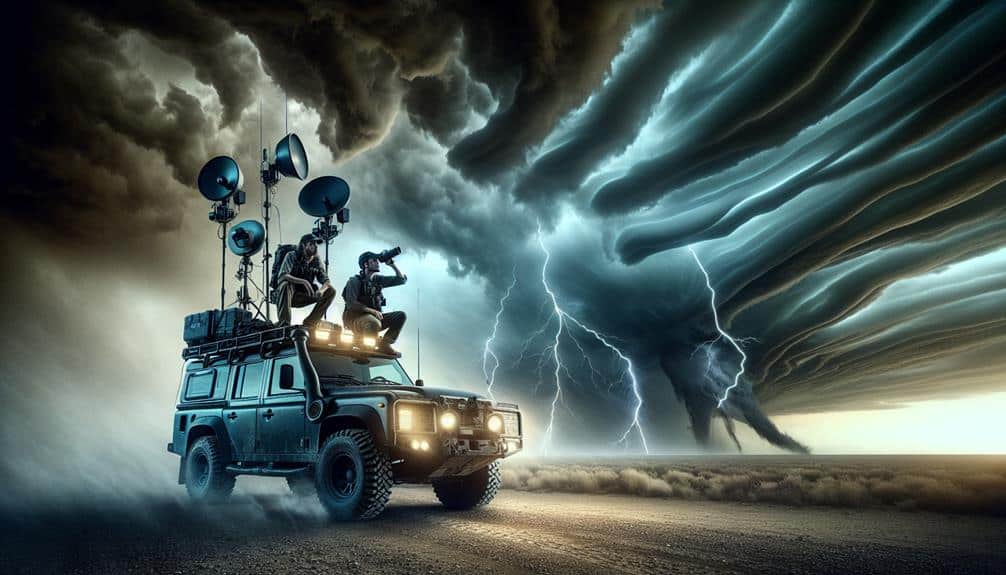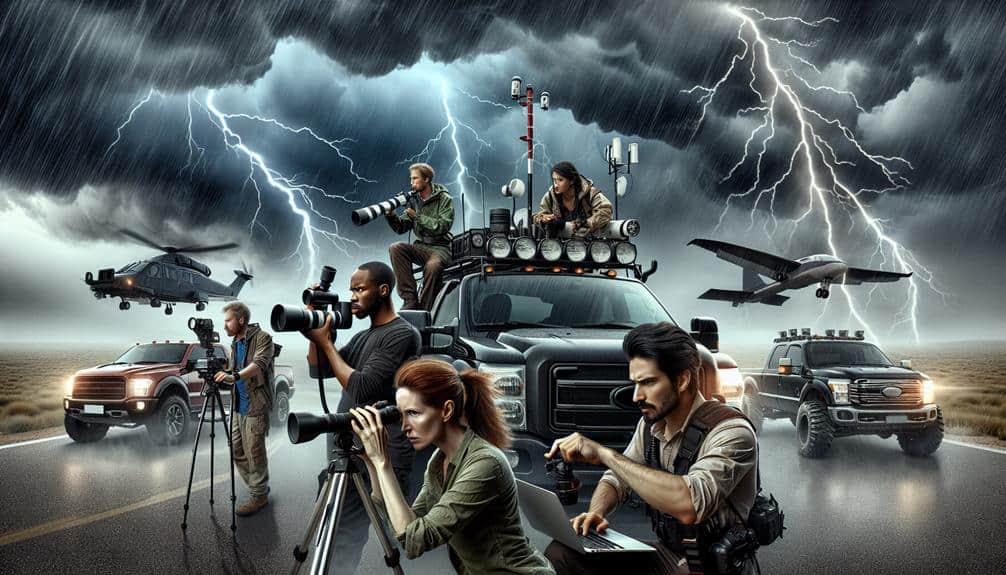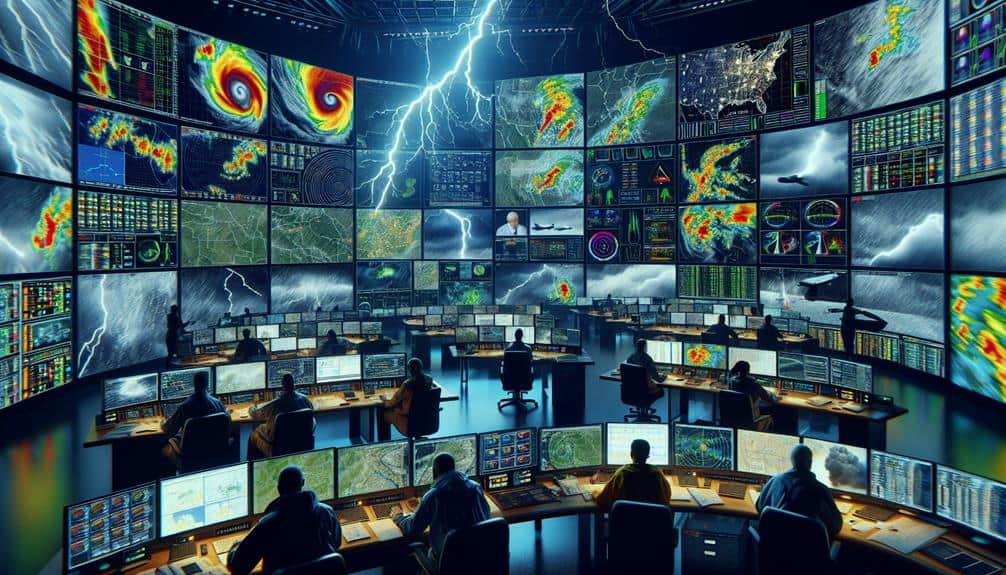We prioritize thorough documentation, starting with reliable, weather-resistant equipment like high-resolution radar units and GPS devices, maintaining regular maintenance. Accurate data recording is key—timestamp every observation and note variables such as temperature, wind patterns, and atmospheric pressure. Detailed photo evidence with GPS coordinates and timestamps enriches our logs. Synchronizing watches with UTC and cross-verifying among team members guarantees time accuracy. Sharing logs within professional networks fosters collaboration and improves validation. Consistently adhering to these practices guarantees high-quality chase logs and leads to refined methods and better analysis in our ongoing storm-chasing endeavors.
Key Points
- Prioritize reliable, weather-resistant equipment and carry backups to ensure continuous data collection during storms.
- Timestamp all observations and synchronize with UTC for accurate data integrity and analysis.
- Document weather conditions such as temperature, wind, precipitation, and atmospheric pressure for comprehensive pattern tracking.
- Capture high-quality images with timestamps and GPS coordinates to contextualize storm development.
Choose Reliable Equipment
When storm chasing, we must prioritize selecting reliable equipment to guarantee safety and data accuracy. The backbone of our success hinges on robust weather tracking systems. High-resolution radar units, GPS devices, and anemometers are essential for real-time storm monitoring. Each piece of equipment contributes uniquely to our ability to predict and track storm patterns, enabling us to position ourselves safely while capturing invaluable data.
To ensure peak performance, equipment maintenance is vital. Regularly calibrating instruments like barometers and thermometers can prevent discrepancies in readings. Cleaning lenses on cameras and making sure that batteries are fully charged will minimize potential failures during critical moments. Additionally, investing in durable, weather-resistant gear protects our tools from harsh elements, preserving their functionality.
We should also consider redundancy in our setup. Carrying backup devices mitigates the risk of equipment failure, ensuring continuous operation even under adverse conditions. Mobile internet hotspots and satellite phones enhance our communication capabilities, allowing us to stay connected and informed regardless of location.
Record Accurate Data
To guarantee our data's reliability, we must timestamp every observation, note weather conditions, and document the equipment used.
This systematic approach helps us maintain consistency and allows for accurate analysis.
Our records will be more robust and valuable for future reference and studies.
Timestamp Every Observation
Every observation must be accurately dated and time-stamped to maintain the integrity of our storm chase data. Precise timestamps allow us to track weather patterns and guarantee data accuracy. Recording the exact time of each observation helps us correlate our findings with meteorological data from other sources, providing a detailed picture of the storm's behavior and progression.
We can't emphasize enough the importance of equipment reliability in this process. Our cameras, GPS units, and data loggers must function flawlessly to capture accurate, real-time information. Any failure in our equipment could result in gaps in our data, making it harder to understand the storm's lifecycle. Using synchronized devices ensures that our photographic evidence aligns perfectly with our observational logs, creating a cohesive dataset.
Timestamping every observation also aids in post-chase analysis. By knowing the precise timing of events, we can reconstruct the storm's path and intensity with greater accuracy. This detailed timeline is invaluable for developing predictive models and improving future chase strategies.
Let's commit to meticulous timestamping to enhance the reliability and accuracy of our storm chase logs, ensuring our data remains strong and actionable for both immediate analysis and long-term study.
Note Weather Conditions
Accurate documentation of weather conditions is important for understanding and predicting storm behavior. As storm chasers, we must meticulously record data to ensure it contributes meaningfully to meteorological research.
Let's focus on four key meteorological elements:
- Temperature Changes: We should track temperature variations throughout our chase. Sudden shifts can indicate atmospheric instability, which is essential for storm development.
- Wind Patterns: Observing and recording wind direction and speed at various altitudes helps us identify potential storm paths and the likelihood of severe weather events. Pay special attention to changes in wind patterns, as they can signal the onset of a storm.
- Cloud Formations: Detailed notes on cloud types and their evolution provide insight into storm structure and intensity. Cumulonimbus clouds, for instance, are often precursors to thunderstorms and tornadoes.
- Atmospheric Pressure: Monitoring pressure changes is important. Rapid drops in atmospheric pressure often precede severe storms, while rising pressure can indicate dissipation.
Document Equipment Used
Effective storm chasing hinges on our diligent use of specialized equipment to capture precise data. To ensure we document accurate information, we must attentively maintain our instruments. Equipment maintenance is essential; a malfunctioning anemometer or barometer can lead to incorrect readings, compromising our weather predictions. By regularly calibrating and inspecting our gear, we safeguard the integrity of our data.
Equally important is data organization. As we gather information from various devices—radars, GPS units, and cameras—we should systematically log each piece of equipment used during a chase. This practice not only facilitates tracking advancements in technology but also aids in cross-referencing data points to verify accuracy. Detailed logs allow us to pinpoint any inconsistencies and make necessary adjustments.
Note Weather Patterns
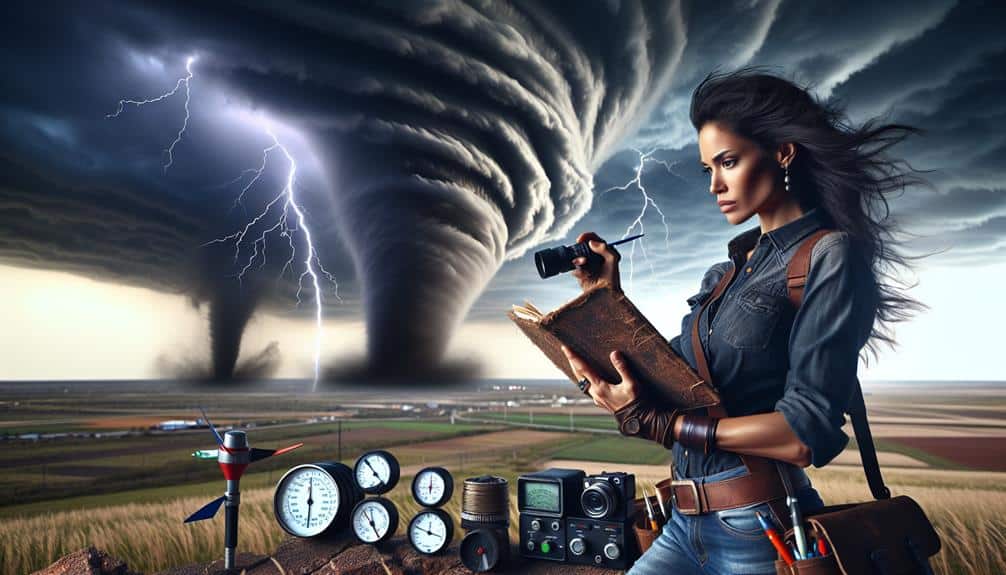
We meticulously record temperature changes, wind speeds, and precipitation levels to identify emerging weather patterns. These data points enable us to analyze storm patterns and improve our forecasting accuracy. By understanding how specific conditions evolve, we can predict storm developments more reliably, offering us the freedom to chase storms safely and effectively.
Our analysis process involves:
- Temperature Trends: Noting sudden drops or rises in temperature can signal the formation of severe weather.
- Wind Speed Variations: Monitoring wind speed changes helps us detect the onset of turbulence or the potential for tornadoes.
- Precipitation Levels: Recording precipitation intensity and type (rain, hail, snow) informs us of the storm's severity and possible impact on the environment.
- Barometric Pressure: Observing pressure fluctuations aids in identifying storm formation and tracking its path.
Recognizing these patterns is pivotal, especially considering the broader implications of climate change. The impact of shifting climate conditions on storm behavior necessitates a meticulous approach to our data gathering. By documenting these weather patterns consistently, we contribute valuable information to the scientific community, aiding in the broader understanding of climate change and its effects on storm activity.
This precise documentation not only enhances our immediate forecasting abilities but also supports long-term climate research, providing a dual benefit to both our chase logs and global climate initiatives.
Document Time Stamps
To guarantee our data's accuracy, we must synchronize our watches precisely before each chase.
By noting key event times, we can create a reliable timeline of the storm's progression.
This precision helps us analyze weather patterns and improve our forecasting methods.
Synchronize Watches Accurately
Ensuring that our watches are synchronized accurately is crucial for documenting precise time stamps during storm chases. Precision in timekeeping enhances the dependability of our weather forecasting and data collection efforts.
When we encounter rapidly changing weather conditions, even minor discrepancies in our recorded times can lead to significant errors in our analysis.
Here's how we can achieve precise synchronization:
- Use a Standard Time Source: We should always synchronize our watches with a reliable time source, such as Coordinated Universal Time (UTC). This provides a common reference point and eliminates the variations caused by different time zones.
- Regular Updates: Synchronize our watches frequently, especially before heading out for a chase. Periodic updates guarantee that any drift in timekeeping is corrected, maintaining accuracy.
- Utilize Technology: Leverage GPS-enabled devices or atomic clocks that automatically update to the correct time. These tools are highly precise and reduce the manual effort required.
- Cross-Verification: Double-check our synchronized times with team members to maintain consistency. Cross-verification helps catch any discrepancies that might've been overlooked.
Note Key Event Times
Having synchronized our watches accurately, it's crucial to meticulously document time stamps for key events during the storm chase. Precise event documentation guarantees data accuracy, which is crucial for later analysis and sharing our findings with the meteorological community.
When we observe significant changes in weather conditions, we must note the exact observation time. This includes the onset of phenomena like hail, tornado touch-downs, and lightning strikes.
By recording these time stamps, we create a reliable timeline that can be cross-referenced with radar data and other observational tools. This level of detail is invaluable for understanding the storm's evolution and predicting future weather patterns.
For instance, when we document the time a funnel cloud first appears versus when it touches down, we can calculate its development speed and trajectory.
Moreover, consistent time stamping allows us to compare our data with other chasers in the field, enhancing the overall data accuracy. Sharing synchronized observations enriches the collective understanding of severe weather events.
Include Photographic Evidence
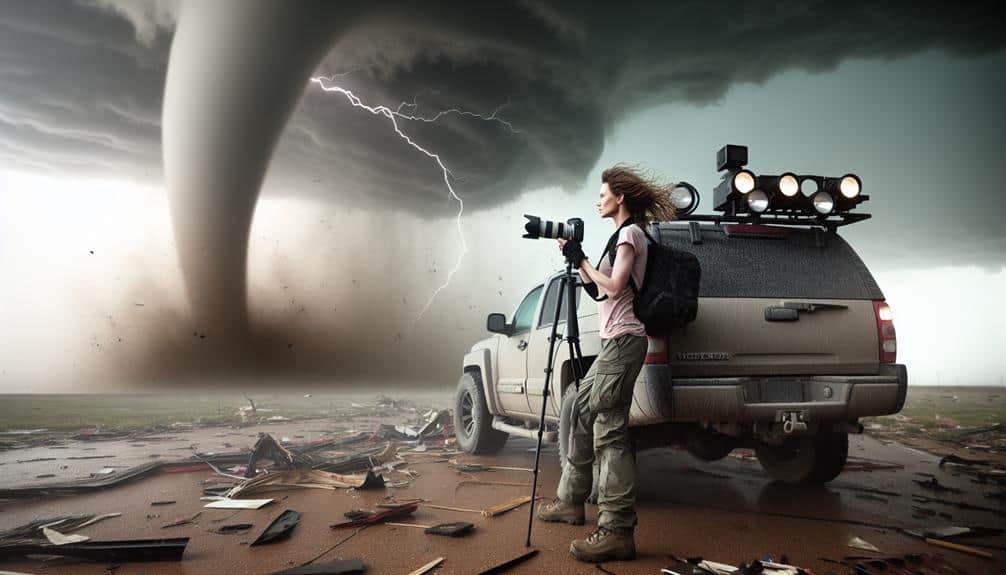
We improve our storm chaser logs by incorporating high-resolution photographic evidence, which offers undeniable visual documentation of our observations. These photos not only capture the intense power of the storm but also serve as crucial data points that can be analyzed later. Utilizing photo editing tools ensures our images are clear and informative, maximizing their value.
To effectively integrate photographic evidence, we follow these steps:
- Capture High-Quality Images: Use a camera with a high resolution to secure detailed shots. This clarity aids in the accurate analysis of storm features.
- Photo Editing: Apply minimal edits to adjust brightness, contrast, and sharpness. Avoid excessive editing, as it can distort the true nature of the storm.
- Contextualize Images: Include timestamps and GPS coordinates. This metadata transforms our photos into powerful tools for visual storytelling, offering a thorough view of the storm's progression.
- Organize Systematically: Arrange images in chronological order within our logs. This organization aids in tracking storm development and provides a coherent narrative.
Sharing our storm chaser logs with professional networks amplifies the impact of our findings and fosters collaborative research efforts. By disseminating our data, we make sure that our observations contribute to a broader understanding of storm patterns and behaviors. This practice not only validates our work but also opens avenues for real-time data analysis by experts in meteorology and related fields.
When we share our logs, we're not just broadcasting information; we're inviting collaborative efforts that can lead to groundbreaking discoveries. Networks like specialized forums, academic institutions, and research organizations can integrate our data into larger datasets, enhancing the precision of weather models and forecasts. The collaborative nature of these networks allows for a multi-disciplinary approach, combining expertise in climatology, atmospheric physics, and data science.
Moreover, sharing our logs facilitates peer reviews and constructive feedback, crucial for refining our methods and improving data accuracy. By engaging with these networks, we maintain a dynamic exchange of ideas and techniques, fostering an environment of continuous learning and innovation.
Essentially, our shared logs become a pivotal part of a collective endeavor to advance meteorological science and safeguard communities against severe weather events.
Review and Analyze Logs
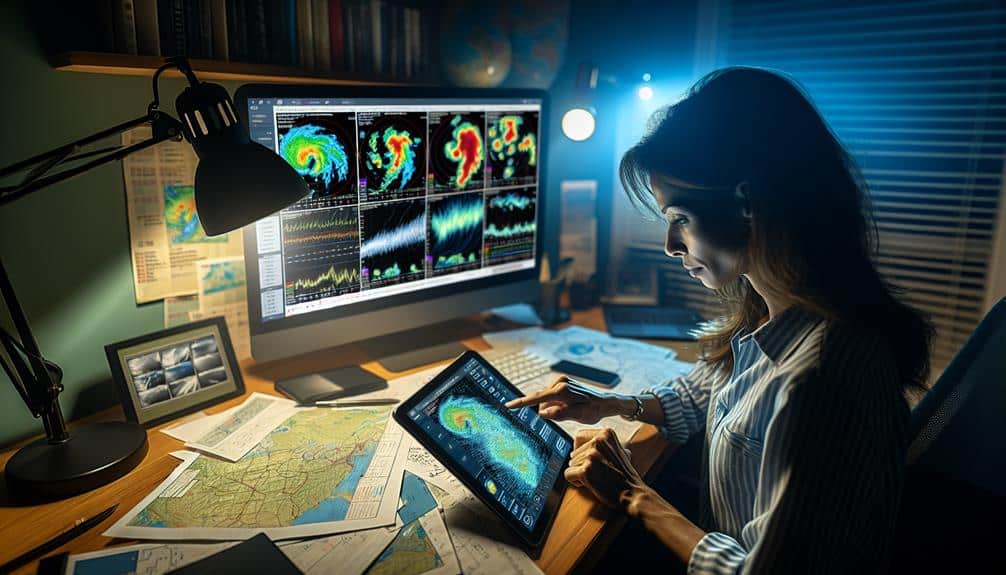
Analyzing our storm chaser logs reveals key patterns and insights that enhance our understanding of storm dynamics. By systematically reviewing our data, we can uncover trends and enhance the accuracy of our forecasts. This process involves several essential steps that secure we extract maximum value from our logs.
1. Analyzing Trends:
We begin by identifying recurring weather phenomena. This step allows us to predict future storm behavior based on past events, thereby refining our forecasting models.
2. Comparing Data:
Next, we juxtapose our logs with external datasets from meteorological agencies. This comparison helps us validate our observations and identify any discrepancies that might necessitate further investigation.
3. Improving Accuracy:
As we compile more data, we need to continually refine our methods. This involves calibrating our instruments and updating our logging protocols to minimize errors and enhance the precision of our data collection.
4. Identifying Patterns:
Frequently Asked Questions
How Do You Ensure Your Safety While Storm Chasing?
We prioritize safety precautions by staying connected with storm chaser networks, following established emergency protocols, and implementing robust communication strategies. Our teamwork and vigilance guarantee we can chase storms while maintaining our safety and freedom.
What Are the Best Apps for Tracking Storms in Real-Time?
Picture the storm's fury vividly unfolding on our screens. The best apps for tracking storms in real-time are RadarScope for detailed weather radar, MyRadar for intuitive visuals, and StormTracker for precise GPS tracking. We maximize freedom with accuracy.
How Do You Plan Your Storm Chasing Route?
We prioritize route planning by analyzing weather models and radar data. For safety, we guarantee our vehicle is equipped with GPS navigation and emergency supplies. Additionally, we take necessary precautions by staying updated on storm developments and road conditions.
What Should Be Included in an Emergency Kit for Storm Chasers?
We must prepare like a well-oiled machine. Our emergency kit should include essential emergency supplies: first aid, water, non-perishable food, and communication devices like radios and chargers. Staying ready guarantees we can chase storms safely and effectively.
How Do You Communicate With Other Storm Chasers During a Chase?
We use radio frequencies and messaging apps to stay in touch during a chase. Communication etiquette is crucial for clear, concise updates. Group coordination guarantees everyone's safety and maximizes our data collection efficiency without compromising our freedom.
